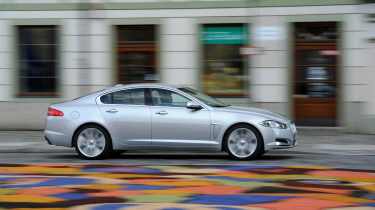Driven: Jaguar XF 2.2D Portfolio
The Jaguar XF has finally got the four-cylinder 2.2-litre diesel engine that buyers have been waiting for.
What is it?
The car that Jaguar should have been selling from when they launched the XF three years ago. Four cylinder diesels don’t set pulses racing, but they’re what sell in the European executive segment, meaning that – since the XF went on sale – Jag has effectively ruled itself out of the running for a majority of potential buyers.
Still, better late than never. We’ve already driven a prototype version of the XF 2.2D, but now we’ve experienced a production-spec version on UK roads.
The engine is the new Ford/ PSA unit, as already seen in the Mondeo and Peugeot 508, but reworked for north-south installation to turn the rear wheels. The power output is slightly down on what Ford claims for the transverse installation, with 188bhp accompanied by a meaty 332lb/ft torque peak. Prices start at £30,950 for the 2.2D SE and rise to £43,050 in range-topping ‘Portfolio’ spec.
Technical highlights:
The clever bit in the powertrain is definitely the eight-speed automatic transmission that sits between engine and rear wheels. As with all XFs, there’s no manual option, and the gearbox has to both maxmise performance but also to deliver those all-important CO2 numbers that decide the amount of tax user-choosers are going to pay for the car.
More reviews
The engine is a retuned version of the one used by Ford and Peugeot, with revised camshafts and a water-cooled turbocharger. It’s considerably lighter than the existing V6 diesel version, saving a claimed 75kg. The official economy numbers are 52.3mpg and 149g/km of CO2.
What’s it like to drive?
The 2.2D XF certainly doesn’t feel like a hair shirt eco special, with decent performance and a sharp, dynamically focussed dynamic experience. The transmission shuffles its deck of ratios almost seamlessly when you request full ahead. Foot to the floor it’s clear that the four-cylinder diesel doesn’t have the lungs of its V6 sisters, but the low torque peak means that real world performance is acceptably brisk.
Not that the junior XF feels much lighter on its feet than its bigger-engined sisters. In fact, our test car’s steering assistance felt a bit too keen, with few messages from the front tyres getting as far as the helm. Ride quality was very impressive though – it’s clear the XF has been set up for rougher British tarmac. And there can be few more refined motorway cars, especially as the gearbox’s stratospheric eighth gear means the engine stays under 2000rpm even at brisk cruising speeds.
It’s hard to like the new stop-start system, though. It’s very aggressive, cutting the motor the moment the car stops moving. And although the engine fires up almost instantly when you release the brake, it quickly begins to feel very pointless in the inch-by-inch grind of urban driving – any spectators must think that you keep stalling the car. The transmission also seems to trip over its feet sometimes at low speeds, with a distinct hesitation while it tries to select the optimum ratio when moving into tight gaps.
How does it compare?
On the numbers, it’s a solid mid-table performance. The Jag is quicker and greener than the Mercedes E220 CDI auto – although it’s still a way off the stellar performance put in by the BMW 5-series. The standard 520D auto manages 54.3mpg and 137g/km – but the new, ultra-green ‘Efficient Dynamics’ version scores 62.8mpg and 119g/km; numbers the XF can’t get close to.
On the plus side, it’s well priced and well specified against its key rivals.
Anything else I need to know?
It’s not the nicest-sounding diesel engine, although excellent noise insulation keeps the cabin quiet. We managed 41mpg for rapid, real-world use.
Specifications
| Engine | 2179cc 4-cyl diesel, turbocharged |
| Max power | 190bhp @ 3500rpm |
| Max torque | 332lb ft @ 2000rpm |
| 0-60 | 8.5 seconds (claimed) |
| Top speed | 140mph |
| On sale | Now |



